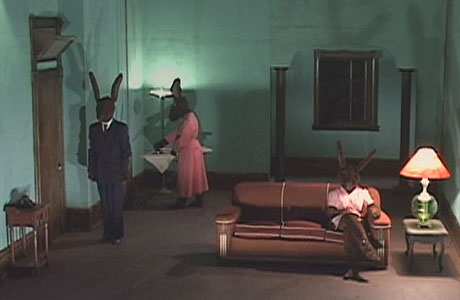May 12, 2008 4
Art Disguised as Crap: Contemporary Deconstructivist Film
I’m no film studies major, but I’ve noticed an interesting trend in film over the last couple years – a series of films has come out that, viewed uncritically as examples of genre filmmaking, are on the surface pretty crappy, or at least seriously out of whack. But viewed as examples of films that deconstruct genre by ironically reflecting convention on the surface while simultaneously rejecting the deeper conventions of filmmaking itself, they are genius.
I’m not sure exactly when this trend started. It might have been with the movie Scream, which parodied the horror genre, while at the same time exemplifying it. Scream also overtly referenced the conventions of horror, while at the same time adhering to them. Essentially, the film openly stated the conventions it was structured around, which should have nullified them, but instead, the conventions were carried out in a way that was self-aware, but still effective; essentially Scream is simultaneously ironic and earnest.
 Scream was well-received and successful, spawning a slew of imitators, but none of them captured the spirit of the original. There were a lot of films produced from the mid-90s onward that displayed a sense of ironic detachment from their own material, but in these cases, the irony was simply self-mockery; none were intended as serious statements about the nature of self-aware art.
Scream was well-received and successful, spawning a slew of imitators, but none of them captured the spirit of the original. There were a lot of films produced from the mid-90s onward that displayed a sense of ironic detachment from their own material, but in these cases, the irony was simply self-mockery; none were intended as serious statements about the nature of self-aware art.
In 2006, David Lynch – a serious and respected art-film director – released Inland Empire. Inland Empire is long, bleak, non-linear, absurdist and essentially incomprehensible – definitely unmistakable for populist feel-good popcorn cinema. Critics and audiences treated it as a serious film, and analysed the deconstructivist nature of the film in earnest. A sample of critics responses:
- Inland Empire is about the effects of movies themselves – the way they change us, inform our goals, and impact our self-image. (Mark Palermo, “Coast”)
- If Hollywood is where dreams go to die, Inland Empire is what it looks like when their lives flash before their eyes. (Duane Dudek, “Milwaukee Journal Sentinel”)
- Imagine what the cinema world would be like if more great directors threw caution to the wind and followed their artistic vision. (Don R. Lewis, “Film Threat”)
- Undeniably, Inland Empire has moments that seem like transmissions from cinema’s future. (Joshua Rothkopf, “Time Out New York”)
Of course, I’m cherrypicking quotes to make a point, but you get the idea. It was hailed by many critics as a bold work of avant-garde genius (Rotten Tomatoes lists it as 70% fresh – a surprisingly high score for a movie that most average viewers would consider unwatchable.)
 Coming out the same year as Inland Empire was Southland Tales, another film that deconstructs film by removing all the familiar signposts of narrative storytelling. But unlike Inland Empire, which stripped away meaning by removing definitive characters and plot, Southland Tales made the same conventions meaningless through an excess of characters and a plot so convoluted it makes little sense even after multiple viewings. Inland Empire is bare and minimalist; Southland Tales deliberately provides an overabundance of visual and aural information that overwhelms the viewer. The result of both films is anxiety and a sense of existential disorientation.
Coming out the same year as Inland Empire was Southland Tales, another film that deconstructs film by removing all the familiar signposts of narrative storytelling. But unlike Inland Empire, which stripped away meaning by removing definitive characters and plot, Southland Tales made the same conventions meaningless through an excess of characters and a plot so convoluted it makes little sense even after multiple viewings. Inland Empire is bare and minimalist; Southland Tales deliberately provides an overabundance of visual and aural information that overwhelms the viewer. The result of both films is anxiety and a sense of existential disorientation.
But while Inland Empire was seen by many critics as a work of genius, Southland Tales was largely panned (Rotten Tomatoes gives it a score of only 35%) – here’s a sampling of the minority of critics who agree with me:
- Whether this is a demented B-movie or a comment on demented B-movies is hard to say. It is horribly fascinating, if not for the full 150 minutes. (Nigel Andrews, “Financial Times”)
- A subversive and annihilistic satire on America. (Urban Cinefile Critics)
- Richard Kelly’s wildly ambitious and widely loathed Southland Tales now seems among the most believable works of film futurism ever made in this country. (Rob Nelson, “Boston Pheonix”)
- We’re plunked down in the middle of an apocalyptic mess. This time the mess is not so much addressed as embodied by the film itself – but damned if it doesn’t roll around in your head a while. (Michael Philips, “Chicago Tribune”)
Of course, the consensus of most critics is best summed up by low-brow populism poster-boy Richard Roeper (of “Ebert & Roeper”): “One of the most confusing, ridiculous, pretentious and disastrous cinematic train wrecks I’ve ever seen.”
Perhaps there’s some truth to that. But I doubt it. I’m pretty sure Southland Tales isn’t even supposed to make sense, that the performances are supposed to be caricatures, and that the overwhelming excess of character and plot is supposed to mimic the sense of alienation and cynicism that we all feel when watching 24-hour cable news. This movie is not about story, it’s about spectacle – in this case, the story becomes a spectacle (and the spectacle becomes the story).
 This brings me to Speed Racer, the latest from the Wachowskis. It goes without saying that most viewers are going to look at this film like a children’s action adventure flick – one a little too heavy on the CG effects and oversaturated colours, and a little low on restraint. However, I see this film not as a straightforward (if somewhat over-the-top) adaptation of a Saturday morning cartoon; rather, this is another film too smart for its own good. Speed Racer is not so much an adventure film as a parody of adventure films; it is as though the Wachowskis brainstormed ways to make a film that was so jarring and violently colourful as to be unwatchable. It’s no secret that films of the last decade have relied more and more heavily on fancy graphics and quick cutting; Speed Racer takes these elements and extrapolates them to a ridiculous degree. It’s a satire of an adventure movie, but one that adheres closely to the conventions that it uses (and then carries to illogical extremes).
This brings me to Speed Racer, the latest from the Wachowskis. It goes without saying that most viewers are going to look at this film like a children’s action adventure flick – one a little too heavy on the CG effects and oversaturated colours, and a little low on restraint. However, I see this film not as a straightforward (if somewhat over-the-top) adaptation of a Saturday morning cartoon; rather, this is another film too smart for its own good. Speed Racer is not so much an adventure film as a parody of adventure films; it is as though the Wachowskis brainstormed ways to make a film that was so jarring and violently colourful as to be unwatchable. It’s no secret that films of the last decade have relied more and more heavily on fancy graphics and quick cutting; Speed Racer takes these elements and extrapolates them to a ridiculous degree. It’s a satire of an adventure movie, but one that adheres closely to the conventions that it uses (and then carries to illogical extremes).
If Speed Racer were simply a children’s movie intended to be eye-catching in the same way as, for example, Tron, then it would have a simple plot and visceral action. But instead, the movie features a plot no child could understand, action so intense that only children raised on modern, fast-cutting video could stomach it, and a use of Freudian symbolism so homoerotic that the whole thing plays like a gay porno. This is a movie children may enjoy, but it is not a movie made for children to appreciate. It satirises not only the cartoon on which its based, but all the action movies of the past 10 years. If it were a little more subdued, it could pass itself off as simply a very extravagant example of modern CG excess, but it is so far beyond the bounds of what could reasonably expected from a movie of this genre that it’s impossible to take it seriously. Instead of just using the conventions of the genre to entertain, it uses these conventions to draw attention to the filmmaking itself, causing the viewer to question these genre conventions and making it impossible to watch the movie without a sense of detachment. The only way to fully understand the egregiousness of the visuals and the campiness of the homoeroticism is ironically.
How is it possible that critics are missing the point (Rotten Tomatoes gives Speed Racer the same abysmal score as Southland Tales – 35%)? From scanning their reviews, it appears that they did, in fact, see Speed Racer as an earnest attempt to make a really good flashy racing movie. And if that were the case, the critics would be correct to write the film off as excessive dross. But its flashiness is not excessive – as a satire of excessiveness, or as an attempt to draw attention to the excessiveness to the exclusion of all else, it’s impossible to be too excessive. Speed Racer is enjoyable as a racing movie, or as a visual delight, but its genius lies not in its success as a genre film, but as a film that explodes its genre by carrying it to such an extreme that it becomes absurd.
All these films share this in common. They take conventions, whether it’s the intentional pretentiousness and precious art-film quality of Inland Empire, the overwhelmingly convoluted and overcomplicated storytelling of Southland Tales, or the visual assault of motion and colour of Speed Racer, and they hyperbolise them to the extent that they become inescapable; they draw attention to themselves through their obviousness, and thereby demolish the genre they exemplify. The effect is that the films cannot be appreciated as examples of genre; instead, they have to be watched as experiences of overwhelming overstimulation – experiences of filmmaking – the viewer has to let go of attachments to the familiarities of convention, and appreciate the films ironically, as examples of post-modern genre self-referentiality.
I could be wrong. But I think these directors are too skillful to not know what they’re doing. You can’t make a satire by accident.
